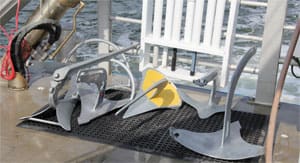In August 2014, Fortress Anchors conducted scientific anchor testing in the Chesapeake, utilizing the 81-foot research vessel Rachel Carson owned by the University of Maryland Center for Environmental Science. Testing was observed by Chuck Hawley, the former Vice President of Product Testing at West Marine, and Robert Taylor, a U.S. Navy anchor design and soil mechanics expert for over 45 years, consulted on the project. The bottom condition was soft mud, which is common in the Chesapeake Bay.
I have long argued that a lot of anchor testing is done in unusual bottom conditions that create odd results, whereas mud is the predominant bottom found in most harbors all around the world. Yes, there are extremely rocky bottoms in Chile, and some people never anchor outside of the sandy Bahamas or the coral-strewn waters of the South Pacific, but still the majority of harbors found up and down the coasts of North America and Europe are mud, which goes for most of the rest of the world, too.
For once, the Chesapeake anchor test eliminated many of the odd variables that have plagued earlier tests. Most of the anchors were of equal weight, the rode and scope were consistent, the bottom conditions were known and common, and the anchor resistance was measured accurately and scientifically. It is worth reading the test procedures to understand how carefully this was all done: http://fortressanchors.com/chesapeake-bay-anchor-test.
Anchors tested included a wide array of current and popular 45-pound steel designs, including many of the so-called “new generation” anchors, like the Mantus, for example. Pitted against these was the venerable Fortress FX-37 aluminum anchor, based on the even more venerable Danforth design dating back to pre-WWII. A 35-pound steel Hi-Tensile Danforth, similar in size and dimensions to the Fortress, was also included.

